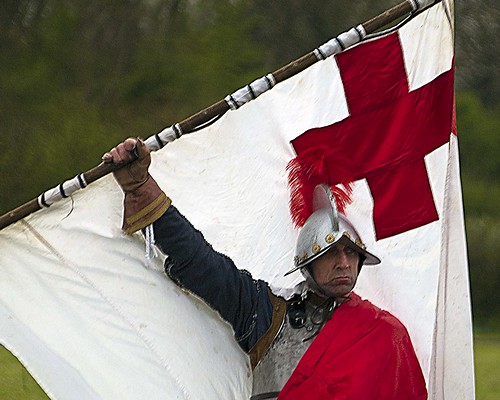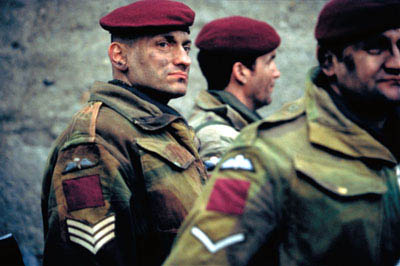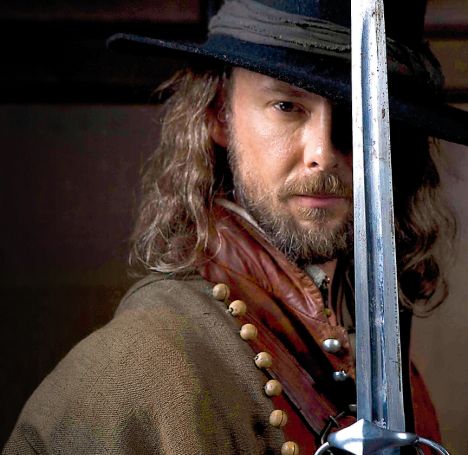 |
| Herbert Gusset, the Earl of Grantham, rides out... |
One idea I've had for this year's gaming is a British Civil Wars campaign. I have all the armies and plenty of terrain and a couple of regular opponents so it should be relatively easy to get something up and going.
I play this period using Phil Barker's DBR rules and like them. The reasons why are like them are expressed far better than I could do by Keith McNelly here:
http://renaissancewargaming.wordpress.com/20-2/
Keith expands on one characteristic of this rule set in another article here:
http://renaissancewargaming.wordpress.com/a-question-of-scale/
One of the distinguishing features of DBR is the option of playing in one of two scales. I believe the flexibility this brings to gaming is well suited to the civil wars in Britain where the vast majority of the engagements were skirmishes and sieges. As Keith points out:
Lets first consider the smaller points budgets, say 100 points. Using normal scale and such a points budget engagements between small armies of 1,000 to 1,500 men can be modeled... the first engagement of the English Civil War at Powick Bridge pitted some 1,000 Parliamentarian horse and dragoons against a similar number of Royalists.
And later on in the piece:
A 400 point Royalist army I recently took to a competition in Australia would, in normal scale, represent an army of 2,800 foot, 900 horse and 200 dragoons. Using condensed scale this same army would represent 11,200 foot, 3,600 horse and 800 dragoons.
However, DBR is not all about competition gaming. If we were to look at the New Model army at the battle of Naseby it comprised some 6,500 horse, 6,000 foot and 1,000 dragoons. This translates to some 40 stands of troops using condensed scale, or some 400 points. In normal scale over 170 stands would be required for the same army, a massive 1,500 points. Clearly the advantages of both scales are now becoming apparent.
So where does that leave us if we're planning a campaign? I tried using a slightly adapted version of this campaign system a couple of years ago:
It's a gem of a system, adapted from the Wargames Foundry 1644 Rules for DBR. Alas, I lost enthusiasm quite quickly as I was playing out the campaign moves solo and tried fighting the battles that were generated both solo and against real opponents and it simply didn't work for me. Firstly, I got bogged down in book keeping. Secondly, I found myself under pressure to do the book keeping during what were very busy weeks in readiness for a game at the weekend. This was neither relaxing nor motivating - I spend a fair chunk of my working life engaged in conflict and a good deal of it on a computer or wading through paperwork, so you can imagine this wasn't much fun.
So, back to first principles. What are the aims of a campaign? After all, I regularly and relatively frequently play British Civil War battles - what would a campaign add? For me, wargaming isn't about 'winning' and 'losing; rather it's more of being involved with an interactive history book, watching events unfold whilst having some influence over them - sending in a cavalry charge and seeing if it does break the enemy foot for example.
So, a campaign would have to add something to that interactive history book. Self evidently this would be a context for a battle in terms of its place in an unfolding narrative - why are these two forces fighting here at this particular point in time?
Crucially, it would have to be fun as well. I can define this better by what it wouldn't be, rather than what it would be. I don't know much about campaigning but I know what I like...
- Minimum bookeeping
- The ability to generate games quickly and with little fuss but in the context of a wider narrative structure
- Balanced games that can be played solo or with an opponent or two but which allow players to choose which side they are playing from game to game, so as to encourage the unfolding history book approach rather than it becoming a competitive event.
- Something that provides an intellectually satisfying distraction from real life.
The approach that best captures this philosophy is, for me, expressed brilliantly by Mark over at Winter of 79, albeit in the context of a 20th Century conflict: www.winterof79.blogspot.com
The campaign is set in the fictional midlands county of Borsetshire (those of you who are familiar with the Radio 4 series The Archers will know this area well) and the approach is described as reflecting the fact
the world has moved on since the days of SPI's Wacht Am Rhine where you would spend months of your life pouring over maps and moving counters. Remember, for us Winter of '79 is a box within which to play our games and sometimes we just want to shake the box and see what ticket we pull out.
I like that...
Using this BBC map of Borsetshire Mark has
placed our campaign arena within a national setting and local geographic context. We've given it key personages, major locations and strategic direction.
Now for the bookeeping part...
Without sweating over how many squaddies, tanks, guns, Garibaldi biscuits or tins of chicken supreme, we know that higher level command and operations are being directed from Felpersham. We've established there's a strong QRF, and a company base at Borchester that's a potential launching pad for smaller scale operations, or even a magnet for attack.
Does it actually matter how many men the Army has in Borsetshire, the composition, size of the population of Felpersham, number of roundabouts etc? No. Remember games are the goal not the detail.
And
We don’t have fixed “armies” to do the paperwork on or keep in command radius on map as the whole thing is “virtual” and decided by chinese parliament. Do we really need to use much more than common sense and perhaps a d6 for randomness. If I say “well, I want a gunned up westland scout” its only fair (for sake of fun game) that somehow, Maff the 'Mad Trot' get a few rpgs/Laws or perhaps a Dushka type weapon. Op Sec? lets presume it cancels out and leaks happen on both sides.
This is starting to look very attractive. The sharp eyed among you will see that there are even a couple of civil war battle sites on the above map at Ambridge itself and also at Francester.
So, here's a go at providing a background for a campaign set in our fictional English midlands county of Borsetshire on the Welsh Marches starting in the summer of 1642, as King and Parliament start to raise armies.
According to Wikpedia http://en.wikipedia.org/wiki/Borsetshire , the two major towns in the county are the cathedral city of Felpersham in the east and the county town of Borchester roughly 17 miles to the west. Obviously, in the 17th Century there would be no railways and, for our purposes, the Felpersham canal doesn't exist either. The road network would be roughly similar, excluding the modern ring road at Borchester, although it would be made up of little more than rough tracks that would be well nigh impassable in the winter months. The river Perch and river Mercer are navigable to to barge traffic.
Borchester is the commercial and adminstrative centre of the county and the local notables, led by a cabal of merchants and minor gentry of godly protestant persuasion, are for Parliament. There is a local trained band in the town and a limited supply of weapons and ammunition in the county magazine.
Felpersham is the seat of the Anglican Bishop, and the governing class, led by the landowning gentry, are for the King. The Lord Lieutenant is the Earl of Grantham, Herbert Gusset, who has extensive lands in the county but rarely visits it. The Royalists see Borsetshire as being of some value given it's proximity to the recruiting grounds of Wales, and the fact it sits astride the so called 'King's Way' from the principality to Oxford, a city where he enjoys great support and which will become his headquarters. It's strategic significance is further underlined by its location on the north-south axis from the midlands and north west England to the gateway to the West Country at Gloucester.
 By September 1642 however the King is still in Shrewsbury, to the north, recruiting and raising funds for arms. The Parliamentarian field army under the Earl of Essex is marching on Worcester and a sharp skirmish, the first of the war, has just taken place at Powick Bridge between Prince Rupert's cavalry and that of Parliament.
By September 1642 however the King is still in Shrewsbury, to the north, recruiting and raising funds for arms. The Parliamentarian field army under the Earl of Essex is marching on Worcester and a sharp skirmish, the first of the war, has just taken place at Powick Bridge between Prince Rupert's cavalry and that of Parliament.
In Borsetshire, several troops of horse, together with some dragoons and commanded shot have marched from Felpersham and crossed the Am at Ambridge. They are probing and scouting the defences of Borchester with a view to assessing whether an attempt can be made to storm the town.
The leader of the Parliamentarian forces in Borsetshire is Edward Dighurst. who has already raised his own regiment of foot to reinforce the Borchester Trained Band and who has enlisted the services of one Alastair Begby, a Scottish veteran of the wars in Germany, and an experienced engineer. The medieval defences of Borchester are being strengthened with earthworks and the Parliamentarians are also seeking to fortify manor houses at Perivale, Leyton Cross and Lakey Green. Word of Royalist troops to the south of the town leads Dighurst to send forth a detachment of horse and commanded shot to see if he can seize the river crossing at Ambridge at cut the King's men off from Felpersham.
On 24 September, the day after the opening action of the war at Powick Bridge, the little known skirmish at Ambridge takes place.























